英语语法比较级最高级
- 格式:ppt
- 大小:3.88 MB
- 文档页数:10

高中英语知识点归纳比较级和最高级的句型比较级和最高级的句型是英语中常用的一种语法结构,用来进行比较和描述物品或人的相对程度。
下面是有关比较级和最高级句型的归纳和总结。
1. 比较级的结构:a) 主语 + be (或其他系动词) + 形容词/副词 + 比较级 + than + 宾语例:Tom is taller than his brother.She runs faster than me.b) 主语 + 动词 + 形容词/副词 + 比较级 + than + 宾语例:My car runs faster than yours.They work harder than us.2. 最高级的结构:a) 主语 + be (或其他系动词) + the + 最高级 + of + 宾语 (当宾语是可数名词时)例:She is the smartest student in the class.He is the tallest boy in the group.b) 主语 + 动词 + the + 最高级 + of + 宾语 (当宾语是可数名词时)例:This book is the most interesting one of all.They are the best athletes in the team.3. 比较级和最高级的句型常用于以下情境:a) 比较两者之间的差异或相似程度- 比较级:A is + 形容词/副词 + than B例:This car is more expensive than that one.He works harder than his sister.- 最高级:A is the + 最高级 + of (all/in) B 例:This is the longest bridge in the country.She is the smartest student in the class.b) 描述一组三者或多者之间的差异或相似程度 - 比较级:A is + 形容词/副词 + than B and C 例:This car is faster than any other car in the race. He runs more quickly than his siblings.- 最高级:A is the + 最高级 + in/of (all) B and C 例:This is the biggest park in the city.She is the tallest among all her friends.4. 比较级和最高级的形容词和副词变化规则:a) 一般形容词/副词 + -er (比较级) + -est (最高级)例:fast - faster - fastesttall - taller - tallestb) 以-e结尾的形容词/副词 + -r (比较级) + -st (最高级)例:large - larger - largestnice - nicer - nicestc) 重读闭音节,末尾只有一个辅音字母的形容词/副词,需双写最后一个辅音字母 + -er (比较级) + -est (最高级)例:big - bigger - biggesthot - hotter - hottest总结:比较级和最高级的句型是一种用来进行比较和描述相对程度的常用语法结构。
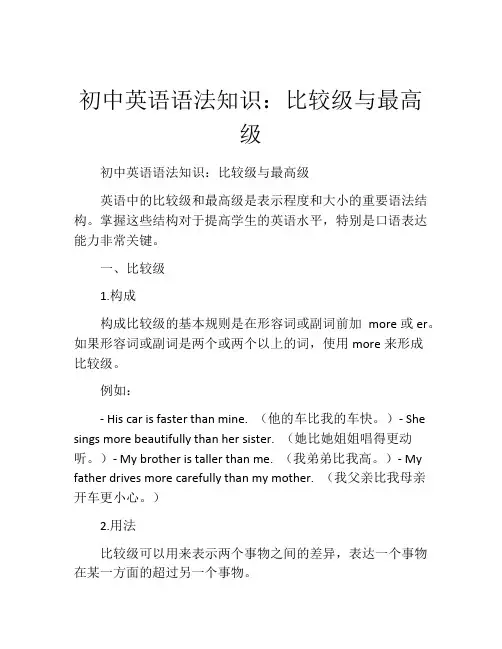
初中英语语法知识:比较级与最高级初中英语语法知识:比较级与最高级英语中的比较级和最高级是表示程度和大小的重要语法结构。
掌握这些结构对于提高学生的英语水平,特别是口语表达能力非常关键。
一、比较级1.构成构成比较级的基本规则是在形容词或副词前加more或er。
如果形容词或副词是两个或两个以上的词,使用more来形成比较级。
例如:- His car is faster than mine. (他的车比我的车快。
)- She sings more beautifully than her sister. (她比她姐姐唱得更动听。
)- My brother is taller than me. (我弟弟比我高。
)- My father drives more carefully than my mother. (我父亲比我母亲开车更小心。
)2.用法比较级可以用来表示两个事物之间的差异,表达一个事物在某一方面的超过另一个事物。
例如:- This book is more interesting than that one. (这本书比那本书更有趣。
)- The test was easier than I thought. (这次考试比我想象中的要容易。
)- Tom runs faster than John. (Tom跑步比John快。
)除此之外,比较级还可以用来表示同一事物在不同时期或不同情况下的变化,以及表示一个事件的过程。
例如:- The weather was colder yesterday. (昨天的天气比今天的更冷。
)- My English has improved a lot over the past year. (我在过去一年里英语进步了很多。
)- I’m f eeling better than I did this morning. (我现在感觉比早上好多了。
)- Susan is getting thinner and thinner. (Susan越来越瘦了。
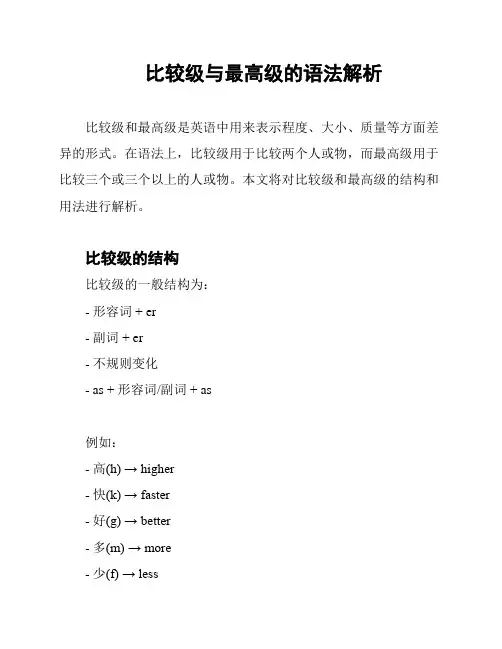
比较级与最高级的语法解析比较级和最高级是英语中用来表示程度、大小、质量等方面差异的形式。
在语法上,比较级用于比较两个人或物,而最高级用于比较三个或三个以上的人或物。
本文将对比较级和最高级的结构和用法进行解析。
比较级的结构比较级的一般结构为:- 形容词 + er- 副词 + er- 不规则变化- as + 形容词/副词 + as例如:- 高(h) → higher- 快(k) → faster- 好(g) → better- 多(m) → more- 少(f) → less- 小(s) → smaller- 大(l) → larger- 长(l) → longer比较级的用法比较级可以用来表达以下三种不同的含义:1. 比较两个人或物之间的差异- My car is faster than yours.(我的车比你的车快。
)2. 表示超过预期的程度- It's hotter today than yesterday.(今天比昨天更热。
)3. 表示变化或发展趋向- The weather is getting colder.(天气变得越来越冷。
)最高级的结构最高级的一般结构为:- 形容词 + est- 副词 + est- 不规则变化- the + 形容词/副词 + est例如:- 高(h) → highest- 快(k) → fastest- 好(g) → best- 多(m) → most- 少(f) → least- 小(s) → smallest- 大(l) → largest- 长(l) → longest最高级的用法最高级用于比较三个或三个以上人或物之间的差异:1. 比较某一类人或物在某个特定方面的优劣- He is the tallest of all the students.(他是所有学生中最高的。
)2. 表示某一物体在某一方面的极限或极端状态- This is the coldest day of the year.(这是一年中最冷的一天。
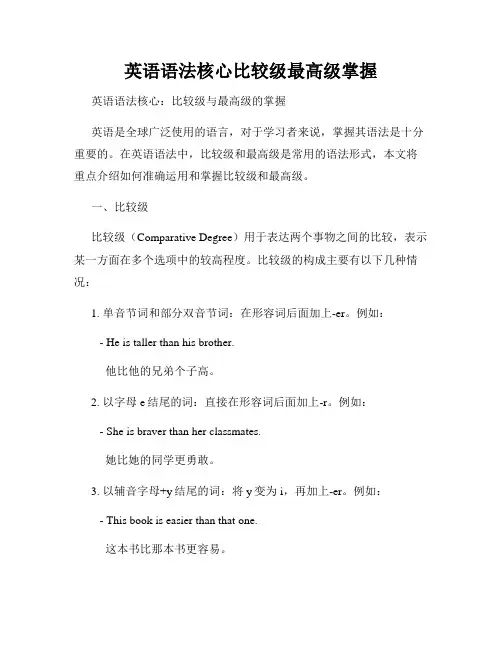
英语语法核心比较级最高级掌握英语语法核心:比较级与最高级的掌握英语是全球广泛使用的语言,对于学习者来说,掌握其语法是十分重要的。
在英语语法中,比较级和最高级是常用的语法形式,本文将重点介绍如何准确运用和掌握比较级和最高级。
一、比较级比较级(Comparative Degree)用于表达两个事物之间的比较,表示某一方面在多个选项中的较高程度。
比较级的构成主要有以下几种情况:1. 单音节词和部分双音节词:在形容词后面加上-er。
例如:- He is taller than his brother.他比他的兄弟个子高。
2. 以字母e结尾的词:直接在形容词后面加上-r。
例如:- She is braver than her classmates.她比她的同学更勇敢。
3. 以辅音字母+y结尾的词:将y变为i,再加上-er。
例如:- This book is easier than that one.这本书比那本书更容易。
4. 因发音规则改变的双音节词和部分多音节词:使用形容词前面加上more。
例如:- She is more beautiful than her sister.她比她妹妹更漂亮。
需要注意的是,部分常用的不规则比较级形式如下:1. good -> better好 -> 更好2. bad -> worse坏 -> 更坏3. little -> less少 -> 更少4. much/many -> more多 -> 更多二、最高级最高级(Superlative Degree)用于表达三者或以上事物之间的比较,表示某一方面在多个选项中的最高程度。
最高级的构成主要有以下几种情况:1. 单音节词和部分双音节词:在形容词前面加上the,再加上-est。
例如:- She is the tallest girl in the class.她是班上最高的女生。
2. 以字母e结尾的词:直接在形容词前面加上the,再加上-st。
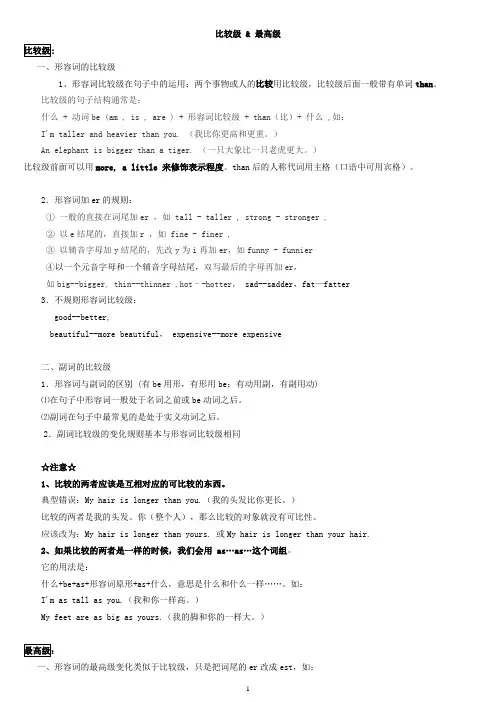
比较级 & 最高级一、形容词的比较级1、形容词比较级在句子中的运用:两个事物或人的比较用比较级,比较级后面一般带有单词than。
比较级的句子结构通常是:什么 + 动词be (am , is , are ) + 形容词比较级 + than(比)+ 什么 ,如:I'm taller and heavier than you. (我比你更高和更重。
)An elephant is bigger than a tiger. (一只大象比一只老虎更大。
)比较级前面可以用more, a little 来修饰表示程度。
than后的人称代词用主格(口语中可用宾格)。
2.形容词加er的规则:① 一般的直接在词尾加er ,如 tall - taller , strong - stronger ,② 以e结尾的,直接加r ,如 fine - finer ,③ 以辅音字母加y结尾的,先改y为i再加er,如funny - funnier④以一个元音字母和一个辅音字母结尾,双写最后的字母再加er,如big--bigger, thin--thinner ,hot–-hotter, sad--sadder,fat—fatter3.不规则形容词比较级:good--better,beautiful--more beautiful, expensive--more expensive二、副词的比较级1.形容词与副词的区别 (有be用形,有形用be;有动用副,有副用动)⑴在句子中形容词一般处于名词之前或be动词之后。
⑵副词在句子中最常见的是处于实义动词之后。
2.副词比较级的变化规则基本与形容词比较级相同☆注意☆1、比较的两者应该是互相对应的可比较的东西。
典型错误:My hair is longer than you.(我的头发比你更长。
)比较的两者是我的头发、你(整个人),那么比较的对象就没有可比性。
应该改为:My hair is longer than yours. 或My hair is longer than your hair.2、如果比较的两者是一样的时候,我们会用as…as…这个词组。

英语语法比较级和最高级用法知识点归纳总结一、比较级的用法1. 用于比较两个人或事物之间的差异或程度,常用结构为“as +原级+ as”或“not as/so +形容词/副词+ as”。
例如:- Mary is as tall as her sister.- This book is not as interesting as the one I read yesterday.2. 用于比较两种情况或行为的差异,常用结构为“比较级+ than”。
例如:- I prefer coffee to tea.- He runs faster than his friend.3. 用于表示“越来越……”的意思,常用结构为“比较级 + and + 比较级”。
例如:- The weather is getting colder and colder.- He is becoming more and more confident.4. 比较级的特殊形式:- 以字母e结尾的形容词,去掉e再加-er。
- 以重读闭音节结尾的单音节形容词和部分双音节形容词,直接加-er。
- 以“辅音字母+y”结尾的形容词,把y变成i再加-er。
例如:- nice → nicer- big → bigger- happy → happier二、最高级的用法1. 用于三个或三个以上人或事物之间的比较,表示最高程度,常用结构为“the + 最高级”。
例如:- She is the tallest girl in the class.- This is the most interesting book I've ever read.2. 最高级的特殊形式:- 以字母e结尾的形容词,去掉e再加-st。
- 以重读闭音节结尾的单音节形容词和部分双音节形容词,直接加-st。
- 以“辅音字母+y”结尾的形容词,把y变成i再加-est。
例如:- nice → nicest- big → biggest- happy → happiest三、比较级和最高级的不规则形式1. 比较级和最高级的不规则形式:good → better → best, bad → worse → worst, many/much → more → most, little → less→ least。
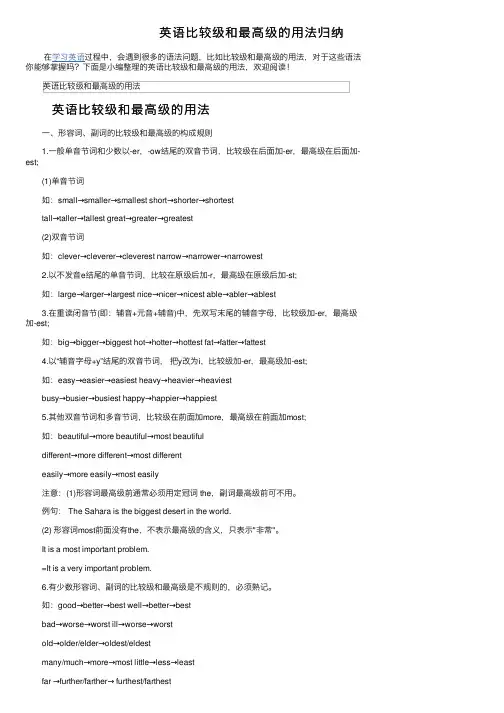
英语⽐较级和最⾼级的⽤法归纳 在学习英语过程中,会遇到很多的语法问题,⽐如⽐较级和最⾼级的⽤法,对于这些语法你能够掌握吗?下⾯是⼩编整理的英语⽐较级和最⾼级的⽤法,欢迎阅读!英语⽐较级和最⾼级的⽤法 英语⽐较级和最⾼级的⽤法 ⼀、形容词、副词的⽐较级和最⾼级的构成规则 1.⼀般单⾳节词和少数以-er,-ow结尾的双⾳节词,⽐较级在后⾯加-er,最⾼级在后⾯加-est; (1)单⾳节词 如:small→smaller→smallest short→shorter→shortest tall→taller→tallest great→greater→greatest (2)双⾳节词 如:clever→cleverer→cleverest narrow→narrower→narrowest 2.以不发⾳e结尾的单⾳节词,⽐较在原级后加-r,最⾼级在原级后加-st; 如:large→larger→largest nice→nicer→nicest able→abler→ablest 3.在重读闭⾳节(即:辅⾳+元⾳+辅⾳)中,先双写末尾的辅⾳字母,⽐较级加-er,最⾼级加-est; 如:big→bigger→biggest hot→hotter→hottest fat→fatter→fattest 4.以“辅⾳字母+y”结尾的双⾳节词,把y改为i,⽐较级加-er,最⾼级加-est; 如:easy→easier→easiest heavy→heavier→heaviest busy→busier→busiest happy→happier→happiest 5.其他双⾳节词和多⾳节词,⽐较级在前⾯加more,最⾼级在前⾯加most; 如:beautiful→more beautiful→most beautiful different→more different→most different easily→more easily→most easily 注意:(1)形容词最⾼级前通常必须⽤定冠词 the,副词最⾼级前可不⽤。
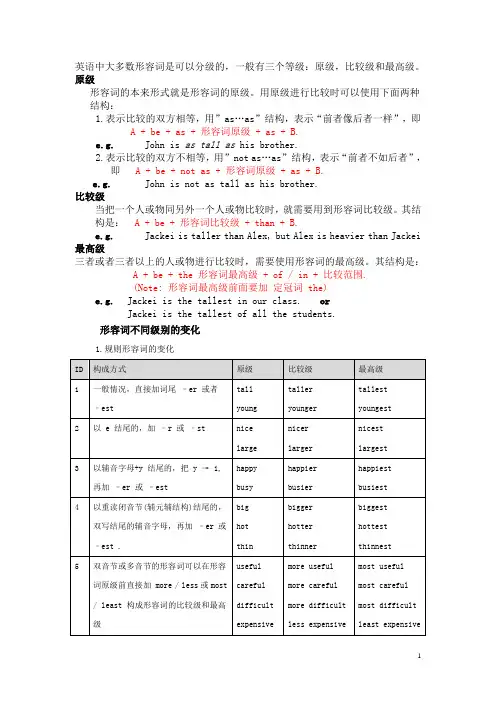
英语中大多数形容词是可以分级的,一般有三个等级:原级,比较级和最高级。
原级形容词的本来形式就是形容词的原级。
用原级进行比较时可以使用下面两种结构:1.表示比较的双方相等,用”as…as”结构,表示“前者像后者一样”,即A + be + as + 形容词原级 + as + B.e.g. John is as tall as his brother.2.表示比较的双方不相等,用”not as…as”结构,表示“前者不如后者”,即 A + be + not as + 形容词原级 + as + B.e.g. John is not as tall as his brother.比较级当把一个人或物同另外一个人或物比较时,就需要用到形容词比较级。
其结构是: A + be + 形容词比较级 + than + B.e.g.Jackei is taller than Alex, but Alex is heavier than Jackei 最高级三者或者三者以上的人或物进行比较时,需要使用形容词的最高级。
其结构是:A + be + the 形容词最高级 + of / in + 比较范围.(Note: 形容词最高级前面要加定冠词 the)e.g. Jackei is the tallest in our class. orJackei is the tallest of all the students.形容词不同级别的变化1.规则形容词的变化2.不规则形容词的变化补充II.副词比较级和最高级的形式副词比较级和最高级的变化形式与形容词基本上一样。
一、一般副词hard→harder →hardest fast→faster →fastestlate→later →latest early→earlier →earliest二、特殊副词well →better →best much →more →mostbadly →worse →worst little →less →least三、开放类副词开放类副词即以后缀-ly结尾的副词不能像形容词那样加-er或-est,而应在副词原形前加more或most。
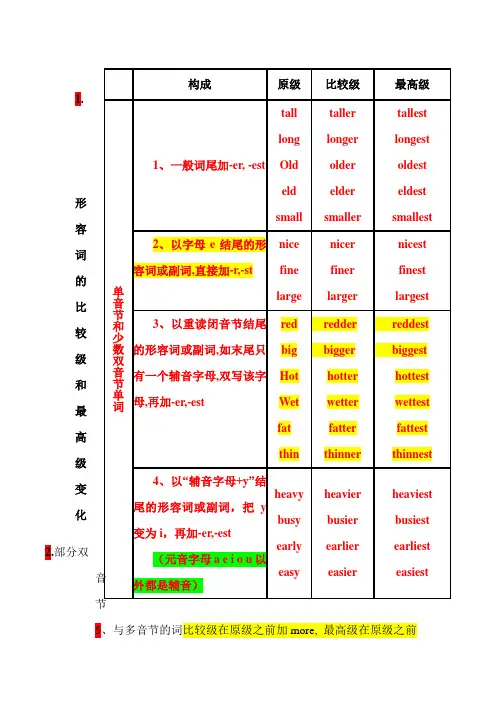
1.形容词的比较级和最高级变化2.部分双5、与多音节的词比较级在原级之前加more, 最高级在原级之前加most ---通常是ful/ing/tant/sive结尾的形容词或者副词,比较级和最高级都是在该单词前加more/most]beautiful---more beautiful---most beautiful(反义---less beautiful不那么漂亮,或者不如...漂亮,例如:Lily is less beautiful than Lucy莉莉没有Lucy 好看]interesting---more interesting -most interestingdifficult--- more difficult-most difficultFriendly--:more friendly --most friendlyExpensive-more expensive-most expensiveImportant--more important-most importantDangerous-more dangerous-most dangerous注意:副词的最高级前可以不加the,但是形容词的一定要加the,和序数词一样。
Fast既是形容词也是副词,不要乱加6.不规则变化的形容词:little (原形)- less (比较级)- least(最高级)Few ---fewer --fewestGood/well(原形)- better(比较级)- best(最高级)bad /ill(原形)- worse(比较级)- worst(最高级)Much/many----more(比较级)---most(最高级)And so on等等(不是等某人的意思,是列举不完后写的,例如I like apples bananas grapes and so on我喜欢苹果香蕉葡萄等等)far (原形)-- further—furthest(表示抽象概念,表示学术或者其他专业知识方面等更深远的意思】far(原形)--farther--farthest【表示具体概念,比如他家是所有人中最远的,表达是His home is the farthest of all,farther和farthest 是表示具体的路程、距离的远】例句:Tom is tall. John is tall. Bob is tall.I'm as tall as you.Tom is as tall as John.Bob is taller than John.John is the tallest of the three.(john是三个人中最高的)Lily is the tallest of the five(莉莉是这五人中最高的)John is the tallest in his class.比较级是两者之间的比较,表示更......、比... (做题思路:通常句子里有than,都用比较级)最高级是三者及以上的比较,意思是最....,(做题思路,通常句子里有of/all/in/among(三者及以上之间)(都是表示范围)等词语,要用最高级)形容词(adj)和副词(adv)的区别:通常副词都是在形容词后面加上ly变成副词,比如quick--quickly happy--happily特别注意:friendly和lovely这两词虽然是ly结尾的,但是不是副词而是形容词---友好的、可爱的另外,有一些形容词的副词形式不是加ly,比如good--well,比如,He speaks english well(well是副词,修饰动词speak)但是另外要注意,well可以用来表示身体好,比如有人问你:how are you?回答可以是--I’m fine、I’m well/I’m very well----记住,well作为形容词用时只可以用来表示身体好,形容词和副词意思基本上都是一样的,只不过形容词是(的),副词是(地),例如:他飞快地跑出去了He runs out quickly用法:副词修饰动词和形容词,形容词修饰名词【注意:感官动词(五官感受的一些词):touch(摸起来)smell(闻起来)sound(听起来)look(看起来)taste(尝起来)feel (感觉,感到)这些词在表示括号里意思的时候,要用形容词修饰,如果不是这些意思,则可以用副词修饰。
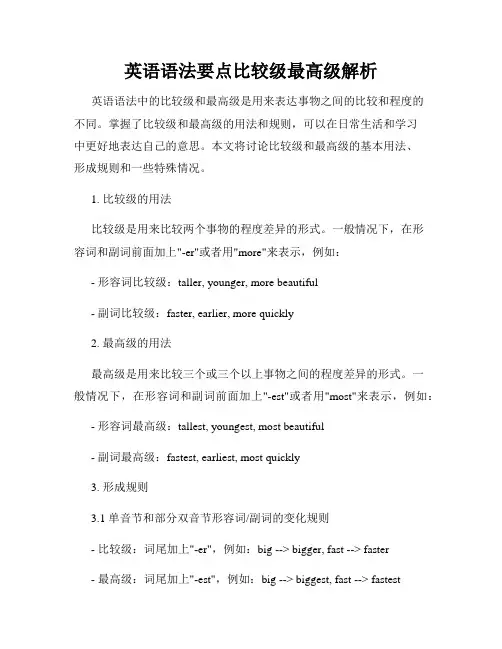
英语语法要点比较级最高级解析英语语法中的比较级和最高级是用来表达事物之间的比较和程度的不同。
掌握了比较级和最高级的用法和规则,可以在日常生活和学习中更好地表达自己的意思。
本文将讨论比较级和最高级的基本用法、形成规则和一些特殊情况。
1. 比较级的用法比较级是用来比较两个事物的程度差异的形式。
一般情况下,在形容词和副词前面加上"-er"或者用"more"来表示,例如:- 形容词比较级:taller, younger, more beautiful- 副词比较级:faster, earlier, more quickly2. 最高级的用法最高级是用来比较三个或三个以上事物之间的程度差异的形式。
一般情况下,在形容词和副词前面加上"-est"或者用"most"来表示,例如:- 形容词最高级:tallest, youngest, most beautiful- 副词最高级:fastest, earliest, most quickly3. 形成规则3.1 单音节和部分双音节形容词/副词的变化规则- 比较级:词尾加上"-er",例如:big --> bigger, fast --> faster- 最高级:词尾加上"-est",例如:big --> biggest, fast --> fastest3.2 多音节形容词/副词和部分双音节形容词/副词的变化规则- 比较级:在词前加上"more",例如:beautiful --> more beautiful, quickly --> more quickly- 最高级:在词前加上"most",例如:beautiful --> most beautiful, quickly --> most quickly4. 特殊情况4.1 以"e"结尾的单音节形容词/副词在变化时只需加上"-r"和"-st"- 比较级:nice --> nicer, wise --> wiser- 最高级:nice --> nicest, wise --> wisest4.2 以"y"结尾的形容词/副词,变化时要改成"i"再加上"-er"和"-est"- 比较级:happy --> happier, easy --> easier- 最高级:happy --> happiest, easy --> easiest4.3 部分形容词/副词变化不规则,需要记忆- 比较级:good --> better, bad --> worse, many --> more- 最高级:good --> best, bad --> worst, many --> most以上是比较级和最高级的基本解析,掌握了这些规则和特殊情况,我们可以更准确地表达事物之间的程度差异。
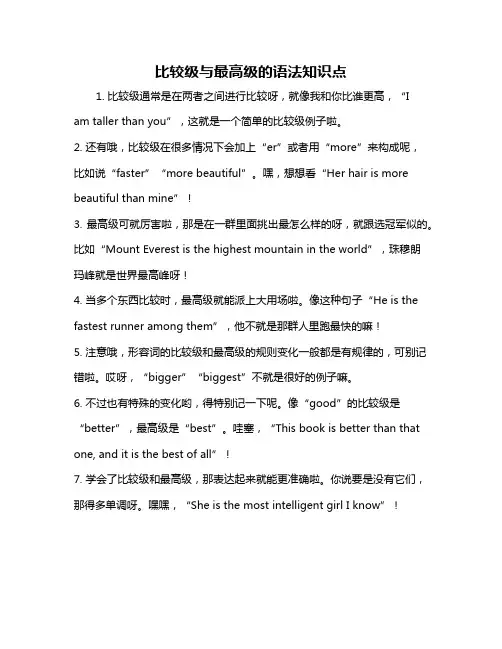
比较级与最高级的语法知识点1. 比较级通常是在两者之间进行比较呀,就像我和你比谁更高,“Iam taller than you”,这就是一个简单的比较级例子啦。
2. 还有哦,比较级在很多情况下会加上“er”或者用“more”来构成呢,比如说“faster”“more beautiful”。
嘿,想想看“Her hair is more beautiful than mine”!3. 最高级可就厉害啦,那是在一群里面挑出最怎么样的呀,就跟选冠军似的。
比如“Mount Everest is the highest mountain in the world”,珠穆朗玛峰就是世界最高峰呀!4. 当多个东西比较时,最高级就能派上大用场啦。
像这种句子“He is the fastest runner among them”,他不就是那群人里跑最快的嘛!5. 注意哦,形容词的比较级和最高级的规则变化一般都是有规律的,可别记错啦。
哎呀,“bigger”“biggest”不就是很好的例子嘛。
6. 不过也有特殊的变化哟,得特别记一下呢。
像“good”的比较级是“better”,最高级是“best”。
哇塞,“This book is better than that one, and it is the best of all”!7. 学会了比较级和最高级,那表达起来就能更准确啦。
你说要是没有它们,那得多单调呀。
嘿嘿,“She is the most intelligent girl I know”!我的观点结论就是:比较级和最高级在英语语法中真的超级重要呀,学会了它们能让我们的表达更丰富、更准确呢!。
比较级和最高级的语法比较级和最高级的语法是英语中用来比较两个或多个事物特征的一种语法形式。
比较级用于比较两个事物的程度或大小,最高级用于比较三个或更多事物的程度或大小。
本文将详细介绍比较级和最高级的语法规则和用法。
一、比较级的语法规则和用法1. 形容词的比较级:形容词的比较级一般在词尾加上-er,例如taller、faster。
同时,要注意在比较级前加上more或less来表示程度更高或更低,例如more beautiful、less expensive。
2. 副词的比较级:副词的比较级一般在词尾加上-er,例如faster、earlier。
同样,也可以在比较级前加上more或less来表示程度更高或更低,例如more quickly、less often。
3. 不规则比较级:有一些形容词和副词的比较级是不规则的,需要记住它们的变化形式。
例如good的比较级是better,bad的比较级是worse。
4. 比较级的用法:比较级的用法可以用来比较两个事物的程度或大小。
例如:My brother is taller than me.(我的哥哥比我高。
)二、最高级的语法规则和用法1. 形容词的最高级:形容词的最高级一般在词尾加上-est,例如tallest、fastest。
同时,要注意在最高级前加上the来表示最高程度,例如the most beautiful、the least expensive。
2. 副词的最高级:副词的最高级一般在词尾加上-est,例如fastest、earliest。
同样,也可以在最高级前加上the来表示最高程度,例如the most quickly、the least often。
3. 不规则最高级:有一些形容词和副词的最高级是不规则的,需要记住它们的变化形式。
例如good的最高级是best,bad的最高级是worst。
4. 最高级的用法:最高级的用法可以用来比较三个或更多事物的程度或大小。
高中英语语法比较级和最高级讲解比较级和最高级是英语语法中用来表达两者之间相对程度的两个形式。
它们可以用来比较词语、短语和从句之间的差异和优劣。
在本文档中,我们将详细讲解高中英语语法中比较级和最高级的用法和规则。
比较级用于表示两者之间的比较,可以用于形容词、副词和一些介词短语。
以下是一些常见的比较级的构成和用法:- 形容词比较级的构成:原级 + er。
例如:tall(高)→ taller(更高)- 形容词比较级的用法:用于两个人或物之间的比较。
例如:Tom is taller than John(汤姆比约翰高)。
- 副词比较级的构成:原级 + er。
例如:quickly(快速地)→ more quickly(更快地)- 副词比较级的用法:用于两个动作或状态之间的比较。
例如:She runs more quickly than him(她跑得比他快)。
- 一些介词短语比较级的用法:例如:in the same way(以相同的方式)、more than(比...更多)等。
2. 最高级(Superlative)最高级用于表示三者或三者以上之间的比较,可以用于形容词、副词和一些介词短语。
以下是一些常见的最高级的构成和用法:- 形容词最高级的构成:原级 + est。
例如:tall(高)→ tallest (最高的)- 形容词最高级的用法:用于三个或三个以上的人或物之间的比较。
例如:Tom is the tallest in the class(汤姆是班级里最高的)。
- 副词最高级的构成:原级 + est。
例如:quickly(快速地)→ most quickly(最快地)- 副词最高级的用法:用于三个或三个以上的动作或状态之间的比较。
例如:She runs the most quickly in the team(她在团队中跑得最快)。
- 一些介词短语最高级的用法:例如:in the same way(以相同的方式)、the most(最多)等。
常用句型之比较级和最高级句结构比较级和最高级句结构是英语语法中常用的句型结构,用于表达两个或多个事物之间的比较关系。
在句子中,比较级和最高级通常起到限定和强调的作用。
下面将介绍比较级和最高级的不同用法和句式结构。
1. 比较级的用法:比较级常用来对两个事物进行比较,表示其中一方在某一方面更大、更高、更好等。
比较级的基本形式为“形容词/副词+er”,或者在词前加上more。
例如:- 苹果比橙子更红。
Apples are redder than oranges.- 他跑得比我快。
He runs faster than me.2. 最高级的用法:最高级用于比较三个或更多事物,表示其中一方在某一方面是“最……的”。
最高级的基本形式为“the+形容词/副词+est”,或者在词前加上most。
例如:- 我的家乡是最美丽的。
My hometown is the most beautiful.- 他是我们班最聪明的学生。
He is the smartest student in our class.3. 比较级和最高级的句式结构:除了基本形式外,比较级和最高级还可以结合其他词语和句式来增强表达的准确性和丰富性。
以下是几种常见的句式结构:- 比较级前加上than引导的从句:- Soccer is more popular in Europe than it is in the United States.足球在欧洲比在美国更受欢迎。
- 超过……倍倍数的表达:- The population of the city is three times larger than that of the town.这个城市的人口是那个小镇的三倍。
- the+比较级,the+比较级的结构:- The more you practice, the better you will become.你练习得越多,你就会变得越好。
- 没有比……更……的了:- There is nothing more important than family.没有比家庭更重要的事情了。
比较级与最高级的比较方式在英语语法中,比较级(comparative degree)与最高级(superlative degree)是表示物体或人在某一属性上相对于其他物体或人的程度的方式。
比较级通过对两个或多个事物进行比较,最高级则对同类事物中的一个进行排名,表示其在某一方面上的最高程度。
本文将介绍比较级与最高级的比较方式。
一、比较级的构成与使用比较级的构成一般需要在形容词或副词后面加上-er或者more。
如果形容词或副词以字母e结尾,则直接加上-r即可。
而有些形容词或副词则需要在其前面加上more。
比较级通常用于两个事物之间的比较,表示两者之间的差异。
例子:1. This car is faster than that one. (这辆车比那辆车快。
)2. She speaks English more fluently than her sister.(她说英语比她姐姐流利。
)二、最高级的构成与使用最高级的构成与比较级类似,一般在形容词或副词后面加上-est或者most。
如果形容词或副词以字母e结尾,则直接加上-st即可。
而有些形容词或副词则需要在其前面加上most。
最高级通常用于对同类事物进行比较,表示其中某一事物在某一方面上的最高程度。
例子:1. He is the tallest student in the class.(他是班上最高的学生。
)2. It is the most delicious cake I have ever tasted.(这是我尝过的最美味的蛋糕。
)三、比较级与最高级的不规则变化除了常规的构成方式外,还有一些形容词和副词的比较级与最高级形式有不规则变化。
例子:1. good - better - best(好-更好-最好)2. bad - worse - worst(坏-更坏-最坏)3. much/many - more - most(多-更多-最多)4. little - less - least(少-更少-最少)四、比较级与最高级的用法比较级与最高级的用法在句子中可以有多种形式,具体可以根据需要灵活使用。
语法解析比较级与最高级的用法比较级和最高级是英语语法中用于比较两个或多个事物特征级别的形式。
在本文中,我们将对比较级和最高级的用法进行详细解析,并提供一些例句来帮助读者理解和运用。
1. 形容词和副词的比较级和最高级形式:形容词和副词的比较级通常通过在词尾加上“-er”来构成,而最高级通常在词尾加上“-est”。
然而,也有一些特殊形式需要记忆,例如“good(好)的比较级是better(更好的)”,“bad(坏)的比较级是worse(更糟的)”,“many/few(多/少)的比较级是more/fewer”。
例句:- Mary is taller than her sister.(Mary比她姐姐高。
)- Tom runs faster than Peter.(Tom比Peter跑得更快。
)- This book is the most interesting one I have ever read.(这本书是我读过的最有趣的一本。
)2. 比较级和最高级的用法:比较级和最高级常用于比较两个或多个事物的级别或程度。
以下是几种常见的使用方式:a. 比较级表示两者之间的比较:- My car is faster than yours.(我的车比你的车快。
)- She is taller than her classmates.(她比她的同学们高。
)b. 最高级表示三者或三者以上的比较:- This is the most expensive necklace in the store.(这是店里最贵的项链。
)- He is the smartest student in our class.(他是我们班最聪明的学生。
)c. 比较级和最高级可以与“than”(比)和“of”(中)连用:- This city is bigger than any other city in the country.(这个城市比国内任何一个城市都大。
初中英语语法之形容词比较级和最高级英语形容词比较级的构成:英语形容词比较等级有三个:原级,比较级和最高级。
一.形容词比较等级形式变化有规则的和不规则的两种。
规则变化1)单音节词末尾加-er(比较级),-est(最高级)【例】原级比较级最高级great greater greatestsmall smaller smallestclean cleaner cleanest2)单音节如以e结尾,只加-r(比较级),-st(最高级)【例】fine finer finestwide wider widest3)闭音节单音节词如末尾只有一个辅音字母,须先双写这个辅音字母,再加-er(比较级),-est(最高级)【例】big bigger biggesthot hotter hottestred redder reddest4)少数以-y,-er,ow,-ble结尾的双音节词,末尾加-er(比较级),-est(最高级)。
以-y结尾的词,如-y前是辅音字母,则变y为-i,再加-er和-est。
以-e结尾的词只加-r和-st。
【例】clever cleverer cleverestnarrow narrower narrowestable abler ablesteasy easier easiest5)其它双音节和多音节词皆在前面加单词more和most。
【例】careful --more careful --most carefuldifficult --more difficult-- most difficultdelicious--more delicious-- most delicious不规则变化原级比较级最高级good/well better bestbad worse worstmany/much more mostlittle less leastfar farther/further farthest/furthest注:有些形容词一般没有比较等级。